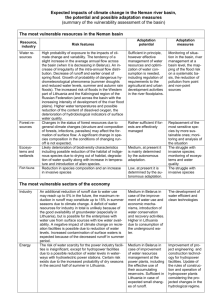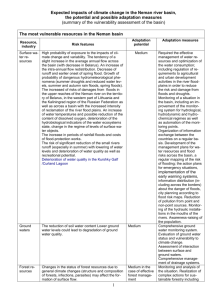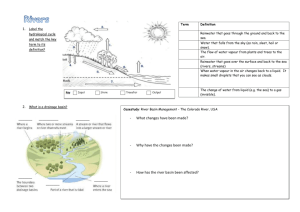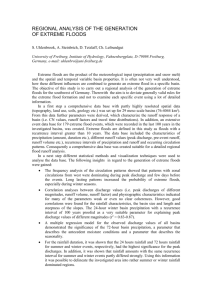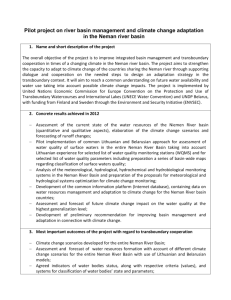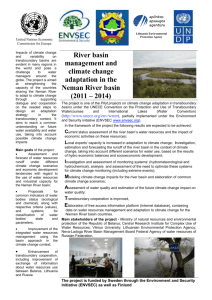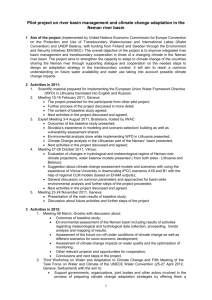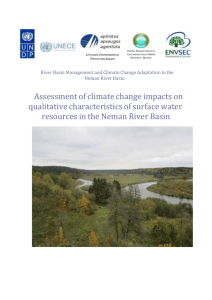Наиболее уязвимые ресурсы в бассейне Днестра
advertisement
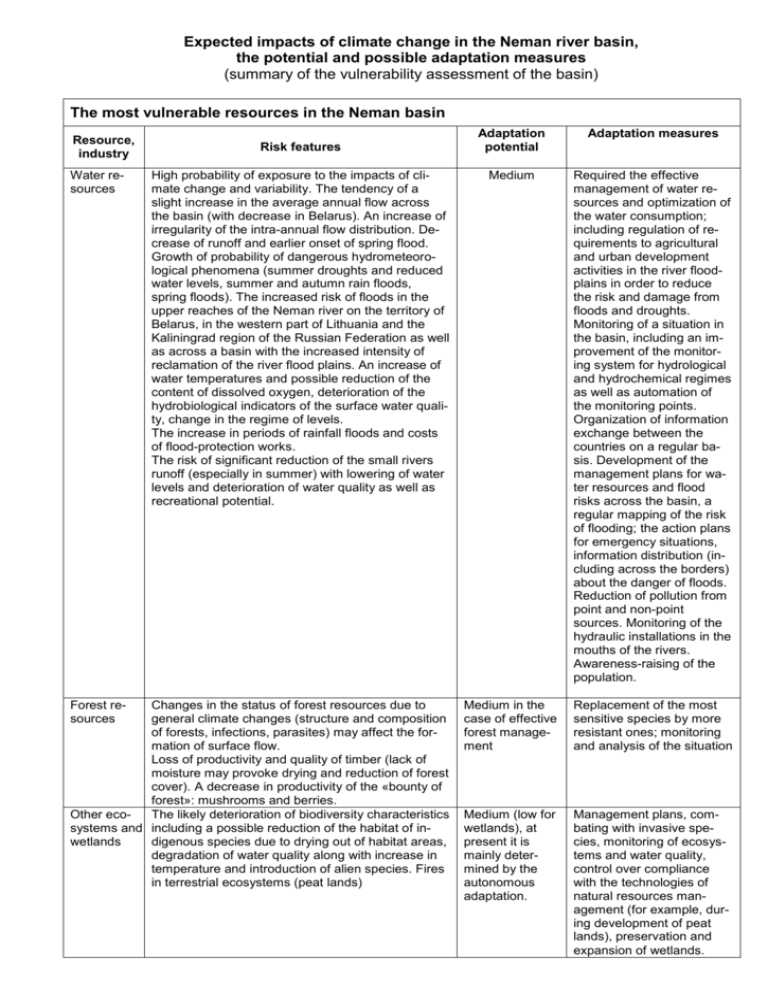
Expected impacts of climate change in the Neman river basin, the potential and possible adaptation measures (summary of the vulnerability assessment of the basin) The most vulnerable resources in the Neman basin Resource, industry Water resources Forest resources Risk features High probability of exposure to the impacts of climate change and variability. The tendency of a slight increase in the average annual flow across the basin (with decrease in Belarus). An increase of irregularity of the intra-annual flow distribution. Decrease of runoff and earlier onset of spring flood. Growth of probability of dangerous hydrometeorological phenomena (summer droughts and reduced water levels, summer and autumn rain floods, spring floods). The increased risk of floods in the upper reaches of the Neman river on the territory of Belarus, in the western part of Lithuania and the Kaliningrad region of the Russian Federation as well as across a basin with the increased intensity of reclamation of the river flood plains. An increase of water temperatures and possible reduction of the content of dissolved oxygen, deterioration of the hydrobiological indicators of the surface water quality, change in the regime of levels. The increase in periods of rainfall floods and costs of flood-protection works. The risk of significant reduction of the small rivers runoff (especially in summer) with lowering of water levels and deterioration of water quality as well as recreational potential. Changes in the status of forest resources due to general climate changes (structure and composition of forests, infections, parasites) may affect the formation of surface flow. Loss of productivity and quality of timber (lack of moisture may provoke drying and reduction of forest cover). A decrease in productivity of the «bounty of forest»: mushrooms and berries. Other ecoThe likely deterioration of biodiversity characteristics systems and including a possible reduction of the habitat of inwetlands digenous species due to drying out of habitat areas, degradation of water quality along with increase in temperature and introduction of alien species. Fires in terrestrial ecosystems (peat lands) Adaptation potential Adaptation measures Medium Required the effective management of water resources and optimization of the water consumption; including regulation of requirements to agricultural and urban development activities in the river floodplains in order to reduce the risk and damage from floods and droughts. Monitoring of a situation in the basin, including an improvement of the monitoring system for hydrological and hydrochemical regimes as well as automation of the monitoring points. Organization of information exchange between the countries on a regular basis. Development of the management plans for water resources and flood risks across the basin, a regular mapping of the risk of flooding; the action plans for emergency situations, information distribution (including across the borders) about the danger of floods. Reduction of pollution from point and non-point sources. Monitoring of the hydraulic installations in the mouths of the rivers. Awareness-raising of the population. Medium in the case of effective forest management Replacement of the most sensitive species by more resistant ones; monitoring and analysis of the situation Medium (low for wetlands), at present it is mainly determined by the autonomous adaptation. Management plans, combating with invasive species, monitoring of ecosystems and water quality, control over compliance with the technologies of natural resources management (for example, during development of peat lands), preservation and expansion of wetlands. Fish fauna Reduction in species composition and an increase in invasive species Medium-low, currently, it is determined by autonomous adaptation. Restoration of species and habitats, combating with invasive species, water protection measures. The most vulnerable sectors of the economy Industry An additional reduction of runoff due to water use may reach up to 5% in the future, the maximum reduction in runoff may constitute up to 15% in summer seasons due to climate change. The water scarcity for the industry in total is unlikely to occur because of good availability of groundwaters (especially in Lithuania), but is possible for enterprises using water from the low-water surface sources. It is likely a negative impact of climate change on the objects of recreation due to reduction of water levels. The increased contamination of surface waters may occur due to decreased runoff in summer period. The reduction of runoff in summer periods will not have a significant impact on the industry development but may negatively influence to the water quality in receiving water bodies considering water scarcity for dilution of wastewaters deteriorating their quality. The risk of water scarcity for power industry facilities is insignificant, except for hydropower facilities due to a possible reduction of water levels in waterways with hydroelectric power stations. Certain risk exists due to the increased probability of dry seasons in the second half of summer across the basin. Medium in Belarus in case of the improved water use and economic mechanisms as well as introduction of water conservation and recovery activities. High in Lithuania due to predominant consumption of groundwaters in industry. The development of water efficient, watersaving and clean technologies (“green economy”), the reduction of wastewater discharges. Improvement of economic mechanisms for water supply and sanitation. Awarenessraising of the population. Medium in Belarus in case of improvement of water resources management at the power plants, including the effective use of their accumulating reservoirs. Sufficient in Lithuania in case of forecasted small changes in runoff. Housing and public utilities Municipal water supply to the settlements in the basin is completely based on the groundwater use; the risk of water scarcity due to climate change is unlikely to occur. It is possible deterioration of water supply in the settlements without centralized water supply due to lowering of the first level of groundwater aquifer and the drying up of wells, as well as additional related costs to develop water supply and sanitation systems, storm water drainage and the local water treatment providing water purification and sanitation. The increase of the drinking water supply to population during warm periods of the year. High, due to water supply from the groundwater sources, improvement of economic mechanisms, systems of water supply and sanitation (including centralization of water supply in rural areas). Agriculture The change in productivity and optimal habitats of Medium Improvement of the engineering projects and the technologies of HPP construction, updating of the rules of HPP maintenance considering the forecasted changes in hydrological regime at the basin level; improvement of the management of releases from reservoirs and wastewater discharges, the increase in using renewable energy sources and use of wastes for energy production. Development of the systems of centralized water supply and sanitation in the rural settlements; the periodical assessment of deposits and groundwater monitoring (quality and quantity indicators). The reduction of areas of waste disposal by improving the systems of their processing. Implementation of measures to reduce the losses of thermal energy and water; modernization and construction of energy efficient buildings. Replacement of agri- Energy Fish industry agricultural crops due to general climate change and possible water scarcity. The risk of water scarcity for agricultural production is unlikely to occur, except for the users abstracting 2-4 million m3 of surface waters in the certain dry periods of low-water years. The climate change impact may increase the pollution of soil and water resources (for example, the increase in irrigated agriculture and the expansion of irrigated areas will lead to a more intensive migration of nitrogen compounds into groundwaters). The strengthening of soil erosion and the deterioration of water quality due to the sharp increase in frequency of intense floods. Possible deficit of water resources for enterprises of the fish industry due to the reduction of runoff and lower levels of surface waters, as well as redistribution among other sectors of the economy. The likely changes may occur in fish fauna, the disappearance or reduction of the spawning grounds may provoke the reduction of fish biodiversity. The changing environment conditions (water temperature, dissolved oxygen, ice regime) will lead to the changes in fish production and species composition (including possibilities of the new fish species breeding). The vulnerability of fisheries and hydrobiological characteristics of the Curonian Lagoon depending on the Neman runoff - their deterioration in the reduction of runoff due to the increase in salinity and their improvement with the increase in runoff due to the reduction of salinity. cultural crops by more productive and resistant varieties (adapted to the new climate conditions). Reduction of pollution from point and dispersed sources. Introduction of effective technologies, including for small farms. Medium in Belarus. High in Lithuania due to privatization of the fish farms. Transport infrastructure, including water transport A possible deterioration of the infrastructure condition as a result of intensification of dangerous hydrological phenomena (dry periods, heavy precipitation), as well as the insufficiency of the legal framework of water resources management (it is using an administrative but not a basin principle of the water management in Belarus, the international agreement across the Neman river basin does not exist). Deterioration of conditions for water transport due to decreased water levels and accelerated accumulation of sediment in the water bodies. Medium due to lack of financing. Higher in case of signing and implementation of the Agreement on the Neman river basin and step-by-step implementation of the basin management principles Health of population Deterioration of water quality in the areas of recreation. The reduction of the drinking water quality in the settlements without centralized water supply. An increase in the water consumption in dry periods. The growing frequency of occurrence of hot and cold periods. Change of conditions for tourism and recreation, including a reduction in the recreation potential for kayaking in cases of lowering water levels in water objects. Medium Effective supervision and optimization of water use. Fish fauna monitoring, regulation of fisheries, the use of possibilities for breeding new species, including the expansion of artificial reservoirs network and aquaculture growing. Additional technological measures in Belarus (aeration, increase in flow, chemical methods). Improvement of the legal and institutional framework of the basin management, awareness-raising of population. Adaptation of water transportation to the increased water level fluctuations, including conducting of engineering activities to improve the capacity of watercourses. Monitoring and forecast of the dangerous hydrometeorological phenomena. Improvement of the land use. Improving of monitoring and control of the surface and groundwater quality, awareness-raising of population. Maintenance of the tourist and recreational infrastructure.
